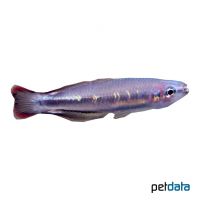Red-tailed Silverside (Bedotia geayi)
| Red-tailed Silverside Bedotia geayi | |
|---|---|
| Name | Red-tailed Silverside |
| Name Lat. | Bedotia geayi |
| Family | Madagascar Rainbowfishes |
| Family lat. | Bedotiidae |
| Order | Silversides |
| Order lat. | Atheriniformes |
| Origin | Madagascar |
| Habitat | Streams, tributaries |
| Diet | Omnivore |
| pH | 6.0-7.5 |
| Behavior | Peaceful |
| Keeping | Swarm |
| Care Level | Moderate |
| Reproduction | Egg scatterer |
| Breeding | Moderately difficult |
| Life Span | 2-5 years |
| Protection | No |
| Metric Units | |
| Size | 9 cm |
| Temperature | 20-25 °C |
| Hardness | < 15 °dH |
| Aquarium | 100 cm / 200 l |
| US Units | |
| Size | 3.5" |
| Temperature | 68-77 °F |
| Hardness | < 267 ppm |
| Aquarium | 50 gal |
Distribution and habitat
Red-tailed spurdogs are found in the 300-650 m high inlets of the Mananjary River in eastern Madagascar. They live in slow-flowing, shady streams and small rivers, and in ponds with clear or brownish (tannin content) water and dense vegetation.
Maintenance
The aquarium should have a dense background and edge planting, with shelters and hiding places (roots) and plenty of swimming space. A dark substrate of sand or fine gravel covered with some foliage (e.g. sea almond leaves) and light slightly shaded with floating plants (e.g. Rizzia) is ideal.
No ammonia, ammonium and nitrite should be detectable, the nitrate value should not exceed 100 mg/l. To ensure the water quality and oxygen content, a filter and heater adapted to the aquarium size is required, as well as lighting for the species-appropriate day-night rhythm of the animals.
Diet
The food supply consists of live food, which is also accepted without problems in frozen form, such as artemia, mysis, daphnia and mosquito larvae or a commercially available frozen food mix. In addition, they need vegetable food such as algae leaves or high-quality dry food (flakes, granules) with vegetable components (spirulina, kelp). No food is taken from the bottom.
It is recommended to feed small portions several times a day. Regular and varied feeding promotes health and prevents deficiency symptoms. Only feed as much as is eaten immediately (in a maximum of 10 minutes).
Behaviour and compatibility
They are lively, swimming schooling fish and at least 5, but preferably many more should be kept together, with a preponderance of females. They are often quarrelsome in groups that are too small. They can be socialized well with rainbowfish of similar size, but also with other peaceful fish. Basically, only compatible fish species with similar water condition and water temperature requirements should be socialized.
Sex dimorphism
Males are more colorful and the anterior dorsal fin is pointedly extended.
Reproduction and breeding
They are free spawners, which during the reproductive period daily in the morning (morning sun) deposit their eggs, which are provided with adhesive filaments, on fine-leaved plants. The fry hatch after 7-10 days. The parents do not engage in brood care.
Fry must be fed several times a day with special rearing food (dust food, Artemia nauplii, infusoria). In community tanks breeding is hardly possible, because the spawn is easy prey.
Important
They like to jump, so the aquarium should be well covered. Temperatures above 25 °C are not tolerated in the long term.
The foliage (sea almond tree, oak, etc.) enriches the water with humic substances and naturally lowers the pH.
The well-being of the fish should be checked regularly. The temperature should be checked daily, the pH, hardness and nitrate value at least every 14 days. Regular partial water changes are recommended, even if the contaminant level has not yet reached the upper limit. Sudden changes in water quality should be avoided. Newly introduced fish must be accustomed slowly to the water in the aquarium
Further literature can be found in your pet store.
References
Text: Werner Winter; Image: petdata
Source: BMELV (1998): Tierschutzgutachten - Haltung von Zierfischen (Süßwasser); RIEHL & BAENSCH (2004): Aquarien Atlas Bd. 1, Mergus Verlag; ENGELMANN (2005): Zootierhaltung - Tiere in menschlicher Obhut: Fische, Verlag Harri Deutsch
- Gemäß § 21 Abs. 5 Tierschutzgesetz idgF
